Division of Animal Behavior
Marlene Zuk Award for best talk: Maria Salazar Nicholls
 Neural control of hatching enzyme release enables rapid escape-hatching in red-eyed treefrogs
Neural control of hatching enzyme release enables rapid escape-hatching in red-eyed treefrogs
‘I am an Ecuadorian PhD student in the Warkentin Lab at Boston University. My research focuses on understanding the mechanisms that underlie adaptive behaviors in early life stages. Specifically, I focus on red-eyed treefrogs and their rapid escape-hatching behavior. I use a multi-faceted approach to elucidate the mechanisms that enable these embryos to achieve rapid escape hatching, from sensory systems to the regulation of their hatching process.’
Elizabeth Adkins-Regan Award for best poster: Isabella Strohmeier
 Maternal defense strategies: investigating female aggression in dyeing poison frogs
Maternal defense strategies: investigating female aggression in dyeing poison frogs
Isabella is an undergraduate student at the University of Illinois Urbana-Champaign advised by Dr. Eva Fischer and postdoctoral fellow Sarah Westrick. She uses dyeing poison frogs (Dendrobates tinctorius) to understand how maternal aggression is modulated by offspring and mate involvement, as well as how testosterone drives female aggression.
Division of Comparative Biomechanics
Wainwright and Koehl Award for best talk: David Cuban
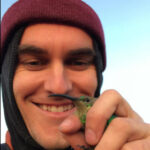
Feeding efficiency of sunbirds and comparisons with other nectar-feeding birds
David studies the convergent evolution of nectar-feeding birds through the lens of biomechanics and ecology. He combines his background in mechanical engineering and robotics with his studies of birds in the field to discover the fundamental physical interactions (biomechanics) of animals. The project he presented at SICB 2024 investigated the feeding efficiencies of sunbirds from both South Africa and Indonesia when feeding on nectar of different sucrose concentrations. The findings show that there is a range of optimal nectar concentration values (between 20% and 40%) for most species with average maximum energy intake rates coming from birds feeding on 30% nectar solutions. Comparing this with previous work with hummingbirds shows that the optimal nectar concentration for hummingbirds is higher at 40%. This discrepancy is likely caused by the distinctive feeding mechanisms each family employs. Examining the nectars offered by plants in South Africa shows that the majority of bird-pollinated plants offer nectar with concentrations of approximately 30% – matching the optimal nectar concentration for sunbirds to maximize their energy intake rate.
Steven Vogel Award for best poster: Clitali Ramirez
 Seafaring with Added Cargo: Simulations of Swimming Blue Blubber Jellyfish with Prominent Oral Arms
Seafaring with Added Cargo: Simulations of Swimming Blue Blubber Jellyfish with Prominent Oral Arms
‘The research I have been working on involves creating numerical simulations of blue blubber jellyfish swimming to explore how the morphology of the blue blubber’s oral arms affect their swimming kinematics. Blue Blubber Jellyfish are of interest because they have large prominent oral arms, fast staccato-like pulsing, and high relative swimming efficiency. Notably, our simulations do not prescribe the motion of the jellyfish, but rather define certain elastic and tensive material properties so that emergent behavior can be observed and validated with experimental data. Our results showed less displacement and higher cost of transport for larger oral arm organisms, and we will do additional simulations tuned to explore potential differences in swimming kinematics among larger oral arm organisms.’
Division of Comparative Endocrinology
Audrey Gorbman Award for best talk: Grace Curtis
 Pleiotropic Roles of Leptin Signaling in Xenopus Tail Tip Regeneration
Pleiotropic Roles of Leptin Signaling in Xenopus Tail Tip Regeneration
My name is Grace Curtis and I’m a PhD candidate in Erica Crespi’s lab at Washington State University. My research focuses on how hormones regulate regeneration in larval Xenopus frogs. Specifically, I am trying to better understand the mechanisms behind how leptin, a nutritional hormone, promotes regeneration in this species. My hope is that this research can someday be applied to improve wound healing in human patients.
Audrey Gorbman Award runner-up: Jennifer Heppner
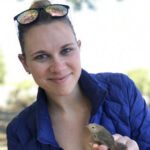 Avian maternal hormone transfer is mediated by limited food in urban environments
Avian maternal hormone transfer is mediated by limited food in urban environments
Jennifer Heppner is a PhD Candidate in Dr. Jenny Ouyang’s lab at the University of Nevada, Reno. Her research focuses on how urbanization and its unique environmental factors, specifically limiting food resources, alter avian physiological (circulating and maternally transferred hormones), behavioral, and morphological phenotypes.
Lynn Riddiford Award for best poster: Lauren Merlino
 Endocannabinoids vary with seasonal life-history transitions in a wild reptile
Endocannabinoids vary with seasonal life-history transitions in a wild reptile
I am a Ph.D. candidate studying under Deborah Lutterschmidt at the University of California, Irvine. My research interests focus on the neuroendocrine mechanisms that mediate behavioral transitions and allow wild animals to navigate shifts between self-maintenance and reproduction. I am also broadly interested in comparative physiology and biochemistry, especially as it relates to animal behavior.
Division of Botany
Rising Star in Botany Award for best talk: Madison Hales
 Control Theory Analysis of Rice Root Response to Frequency-dependent environmental stimuli
Control Theory Analysis of Rice Root Response to Frequency-dependent environmental stimuli
I am a Robotics PhD Student at the Georgia Institute of Technology, and my research leverages techniques from robotics and control theory to characterize how plant roots use environmental stimuli to navigate complex environments. I would like to dedicate this award to my late mentor and colleague Dr. Philip Benfey, whose enthusiasm and curiosity for plant biology continue to inspire my work in botany every day.
Division of Comparative Physiology and Biochemistry
Best student talk: Jessica Karr and Kelly Robinson
 Karr: The effects of rain and cold temperature on thermogenic capacity and physiology in captive finches
Karr: The effects of rain and cold temperature on thermogenic capacity and physiology in captive finches
I am a fourth year PhD candidate in Dr. Jamie Cornelius’ Lab at Oregon State University. My current research focuses on the impact of precipitation and temperature on metabolic physiology. I am particularly interested in how extreme weather may impact songbird physiology and survival.
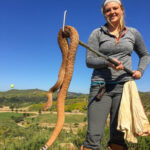 Robinson: Investigating toxicokinetics of newt (Taricho) tetradoxin in garter snakes (Thamnophis)
Robinson: Investigating toxicokinetics of newt (Taricho) tetradoxin in garter snakes (Thamnophis)
I am a PhD Candidate at the University of Nevada – Reno where I am advised by Dr. Chris Feldman. I am primarily interested in understanding the physiological and molecular mechanisms involved in venom and toxin resistance typically using reptiles and amphibians. I am currently studying the evolution of toxin resistance mechanisms in garter snakes and tetrodotoxin in newts.
Best student poster: Julia Kelso
 Impact of individual plasticity and supergene genotype on C. maenas heat wave response
Impact of individual plasticity and supergene genotype on C. maenas heat wave response
My name is Julia Kelso and I am a senior undergraduate at Cornell University. I study Biological Sciences with a concentration in Genetics, Genomics, and Development; I am particularly interested in gene regulation, differential expression, and proteomics. I was given the amazing opportunity to study thermal tolerance and supergene expression in global invader Carcinus maenas with the Tepolt Lab at Woods Hole Oceanographic Institution over the summer of 2023, and I am continuing to explore differential expression in C. maenas for my honors thesis here at Cornell.
Best student poster runner up: Trisha Panganiban
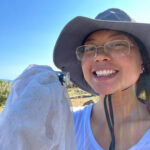 Dietary carbohydrates increase heat stress resistance of honey bees’ foragers
Dietary carbohydrates increase heat stress resistance of honey bees’ foragers
Trisha Panganiban is a 5th year undergraduate student at California State University, Los Angeles, currently studying Biology and Women’s Gender and Sexuality Studies. Through a competitive internship with the National Science Foundation and the University of Central Oklahoma, she performed an 8-week intensive research study looking at how diet can increase honeybee survivability in response to global warming.
Division of Evolutionary Developmental Biology
Best student talk: Harsha Sen
 Molecular evolution and development of the mammalian gliding membrane
Molecular evolution and development of the mammalian gliding membrane
I am a third-year PhD student in the Mallarino Lab at Princeton University. I study the evolution and development of the mammalian gliding membrane (also known as the patagium), and I am broadly interested in understanding biological systems from evolutionary, developmental, and genomic perspectives by developing and using computational and molecular tools.
Best student poster: Erica Nadolski
 Evolutionary novelties, segmental boundaries, and unexpected Hox gene expression in the insect head
Evolutionary novelties, segmental boundaries, and unexpected Hox gene expression in the insect head
Erica Nadolski is a PhD candidate working in the Moczek lab at Indiana University. She fell in love with insect diversity as an undergraduate working with novel secondary sexual traits in fruit flies, and now works on the genomic mechanisms underlying the origin and diversification of sexually dimorphic traits in horned beetles. She plans to pursue an academic career leveraging diverse insect models, functional genetics, and genomics in a comparative eco-evo-devo framework.
Division of Ecoimmunology and Disease Ecology
Best student talk: David Clark
 Experimental epidemics reveal that host sex and sociality impact transmission within host groups
Experimental epidemics reveal that host sex and sociality impact transmission within host groups
I am a PhD candidate in Jessica Stephenson’s lab at the University of Pittsburgh. I use a Trinidadian guppy and Gyrodactylus parasite system to research the interaction between sex variation and infectious disease across multiple scales.
Best student poster: Lorraine Pérez
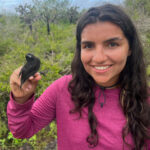 Cigarette tobacco reduces the survival of invasive parasites that affect Darwin’s finches
Cigarette tobacco reduces the survival of invasive parasites that affect Darwin’s finches
Lorraine Pérez is finishing her undergraduate degree in Ecology and Evolutionary Biology at the University of Connecticut. She will be starting her MS at UConn in Fall 2024.
Division of Ecology and Evolution
Ray Huey Award for best student talk: Emily Lau
 Horizontally transferred genes are recruited in the evolution of lensed light-interacting organs
Horizontally transferred genes are recruited in the evolution of lensed light-interacting organs
I am a PhD candidate working with Todd Oakley at the University of California, Santa Barbara. I study the molecular evolution of bioluminescence in toadfishes, brittle stars, and ostracod crustaceans. To what extent is evolution predictable? How do complex traits repeatedly evolve? To address these questions, I investigate how bioluminescence, the biological production of light by a living organism, convergently evolved. During this year’s DEE session, I presented results that show an ancient horizontal gene transfer may have provided the genetic raw material for the evolution of lensed light-producing organs in luminous toadfishes. In addition to toadfishes, I also study the molecular evolution of bioluminescence in ostracod crustaceans and brittle stars. Many thanks to DEE and conference organizers for giving me the opportunity to share my work! SICB is such an incredible community of researchers and I’m looking forward to seeing everyone again in future meetings!
Ray Huey Award honorable mention: Annelise Blanchette
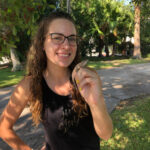 Lead exposure is associated with limited physiological effects in urban lizards
Lead exposure is associated with limited physiological effects in urban lizards
I study how soil-based lead exposure affects brown anole lizards in New Orleans. This includes comparing their blood lead levels to the soil lead levels of the neighborhood they live in, testing the physiological outcomes of exposure, and identifying what molecular mechanisms they may use as protection against lead toxicity. I’ve found that the brown anole is very tolerant of high levels of lead and displayed no obvious negative symptoms of such high exposure. I am preparing to defend my work on March 22, and I’m very grateful I was able to share it at SICB 2024!
Ray Huey Award for best student poster: Megan Hemmerlein
 Developmental origins of adaptation to high elevation in the deer mouse placenta
Developmental origins of adaptation to high elevation in the deer mouse placenta
My research explores the molecular mechanisms that underlie gestational adaptation to high elevation. Specifically, I focus on how the placenta mitigates fetal growth restriction using deer mouse populations (Peromyscus maniculatus) adapted to high-elevation conditions compared to their ancestral low-elevation counterparts. My current work as part of the DEE Huey Award competition focused on how the transcriptomic landscape of the placenta changes across development. I am so grateful for the opportunity to present my work at SICB and look forward to engaging with members of the DEE next year!
Ray Huey Award honorable mention: Fallon Meng
 Uncovering the Population Structure and Genetic Diversity of the Spotted Lanternfly
Uncovering the Population Structure and Genetic Diversity of the Spotted Lanternfly
My research centers on the evolutionary strategies of the invasive Spotted Lanternfly (SLF) in urban environments across the northeastern United States. I’m focusing on population genetics, genomic and phenotypic adaptations such as thermal tolerance in urban settings. Utilizing a combination of genomic analysis and phenotypic research, I aim to understand how these invasive insects adapt and survive in city landscapes. Beyond my research, I am deeply involved in NYU Biology’s community, co-organizing an eco-evo group for relevant workshops to foster a collaborative and dynamic research environment. I’d like to express my sincere gratitude to the SICB and DEE for supporting student endeavors and for the honor of participating in the best student presentation competition. This experience has been incredibly rewarding, and I eagerly anticipate participating in SICB 2025 to share my progress and engage with the vibrant community of researchers!
Division of Invertebrate Zoology
Mary Rice Award for best talk: Callum Backstrom
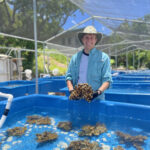 Tracking heavy metals during bleaching stress and recovery in Hawaiian reef-building corals
Tracking heavy metals during bleaching stress and recovery in Hawaiian reef-building corals
I am a fourth-year graduate student (masters-bypass PhD track) in the Padilla-Gamiño lab at the University of Washington’s School of Aquatic and Fishery Sciences. I study the interactive effects of multiple stressors on reef coral physiology and health, focusing on how ocean warming affects the levels of anthropogenic pollutants (such as heavy metals and microplastics) that are ingested by corals and passed to their offspring.
Mary Rice Award honorable mention: Erik Etzler
 Exposure to traffic noise changes baseline auditory neural activity and decision-making in crickets
Exposure to traffic noise changes baseline auditory neural activity and decision-making in crickets
My name is Erik Etzler. I’m a 5th year Phd Student at the University of Toronto Mississauga where I study how urban noise can mediate how orthopterans interact with each other and with predators.
Alan Kohn Award for best poster: Ethan Kahn
 DNA Barcoding Nemertean Diversity in the Red Sea
DNA Barcoding Nemertean Diversity in the Red Sea
I am a 3rd year undergraduate at UCLA, majoring in Ecology, Behavior, and Evolution and minoring in Linguistics. I am excited to explore biodiversity, systematics, and the intersection of ecological function with evolutionary pressures.
Alan Kohn Award honorable mention: Gabrielle Johnson
 Nearing the Max: Thermal Stress Decreases Larval Survival in Tortoiseshell Limpets
Nearing the Max: Thermal Stress Decreases Larval Survival in Tortoiseshell Limpets
Gabrielle Johnson is a junior at Swarthmore College studying biology and statistics. Her primary research pursuits are rooted in her interests in quantitative biology and climate change science!
Wenner Award: Theodora Po
 Directional control of phototactic behavior in sea stars
Directional control of phototactic behavior in sea stars
I am a 6th-year PhD Candidate in Matt McHenry’s Lab at the University of California, Irvine. I am fascinated by the interplay between collective behavior and central control of biological and engineered systems. I am a 6th-year PhD Candidate in Matt McHenry’s Lab at the University of California, Irvine. I am fascinated by the interplay between collective behavior and central control of biological and engineered systems or movement and sensing. I use a combination of experimentation, robotics, and mathematical modeling to explore this concept in the hundreds of appendages called tube feet in sea stars. I look forward to conducting research in neurophysiology, soft robotics, and animal behavior to further our understanding of control in animal locomotion and to develop bio-inspired control algorithms.
Division of Neurobiology, Neuroethology, and Sensory Biology
Best student talk: Viral Mistry

Distinct network-level strategies for different forms of non-associative learning in Tritonia
I’m a Ph.D candidate in the Stanson-Toshok Center for Brain Function and Repair at Rosalind Franklin University of Medicine and Science. My research uses optical electrophysiology to investigate how sea slug escape locomotion neural networks are reorganized under learning and memory.
Best student talk honorable mention: Tanner Mierow
 Amphibious compound eyes: ontogenetic shifts in eye morphology and function in Belostoma flumineum
Amphibious compound eyes: ontogenetic shifts in eye morphology and function in Belostoma flumineum
I am a second year PhD student in the Kingston Lab at the University of Tulsa. I am fascinated by invertebrate sensory systems and their adaptations. Currently, I work on the sensory biology of aquatic insects and the neuroethology of snapping shrimp-goby mutualisms.
Best student poster: Karin van Hassel
 Modulation of the stretch feedback pathway in the heart of the American lobster, Homarus americanus
Modulation of the stretch feedback pathway in the heart of the American lobster, Homarus americanus
My name is Karin van Hassel and I am an undergraduate at Bowdoin College majoring in Neuroscience. I am graduating in the spring and excited to continue growing my love for Neurophysiology!
Best student poster honorable mention: Roeskva Torhalsdottir
 Decoding social communication in a eusocial ant species, Harpegnathos saltator
Decoding social communication in a eusocial ant species, Harpegnathos saltator
I am an undergraduate student at Middlebury College with a major in Molecular Biology and Biochemistry. I work in the Pask Lab where we study chemical communication in the Indian Jumping Ant
Division of Phylogenetics and Comparative Biology
Wake Award for Best student talk: Alexus Roberts Hugghis
 The modified pharyngeal jaw constrains the diversification of fish feeding kinematics
The modified pharyngeal jaw constrains the diversification of fish feeding kinematics
As a Postdoctoral Scholar at the University of Bern, my research combines functional morphology, kinematics, and phylogenetic comparative methods to explore how key innovations impact disparity, integration, and rates of evolution within musculoskeletal systems. I primarily focus on novelties within the oral and pharyngeal jaws of fishes with the ultimate goal of understanding how major trait changes contribute to the incredible morphological, functional, and lineage diversification seen across this vertebrate group. As a Black woman who is no stranger to systemic obstacles faced by historically marginalized students in STEM, I am also dedicated to fostering diversity, equity, inclusion, and justice within Ecology & Evolutionary Biology and higher education, more broadly.
Wake Award for Best student talk honorable mention: Shih-Na Liu
 Diet drives varied rates of body shape evolution in reef fish
Diet drives varied rates of body shape evolution in reef fish
I am a third-year undergraduate studying Evolution, Ecology, and Biodiversity at UC Davis. My current research in the Wainwright lab uses phylogenetic comparative methods to study the drivers of morphological diversity in fishes. With a strong interest in macroevolution, I hope to further explore the intrinsic and extrinsic factors that shape evolutionary patterns through deep time.
Wake Award for Best Student Poster: Devin Mendoza
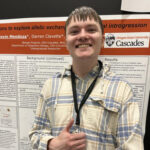 Genomic simulations to explore allelic exchange via reciprocal introgression
Genomic simulations to explore allelic exchange via reciprocal introgression
As a senior at OSU-Cascades, I’m blending my passions for entomology and computer programming, majoring in Biology with minors in Chemistry and Computer Science. My academic journey has been spent merging technology and biology doing research in our bioinformatics lab. I’m interested in combing the realms of biology and computer science in a field such as bioinformatics
Division of Vertebrate Morphology
D. Dwight Davis Award for Best student talk: Noraly van Meer
 Quantification of three-dimensional architecture of axial muscle fibers in larval fish
Quantification of three-dimensional architecture of axial muscle fibers in larval fish
I am a PhD candidate in the Experimental Zoology Group at Wageningen University in The Netherlands, where I am currently studying the developmental changes in axial muscle morphology and activation patterns in larval zebrafish.
D. Dwight Davis Award for Best student talk honorable mention: Adrien Arias
 Upright limb posture reduces muscle work during locomotion
Upright limb posture reduces muscle work during locomotion
Adrien completed his Ph.D. at UC Irvine last summer and is now a Postdoctoral Research Fellow at University of San Diego working with Dr. Nicole Danos. His research focuses on how the mechanical properties of muscle-tendon units influence muscle function and energetics during locomotion. He is currently studying skeletal muscle function during pregnancy and lactation in rats.
Karel Liem Award for Best Student Poster: Nicole Whelpley
 Developmental impacts of environmental hypoxia on embryonic anemonefish
Developmental impacts of environmental hypoxia on embryonic anemonefish
I am a master’s student at The University of Massachusetts – Dartmouth and a member of the Kavanagh lab. My work focuses on how chronic hypoxia exposure may affect anemonefish embryonic development.

